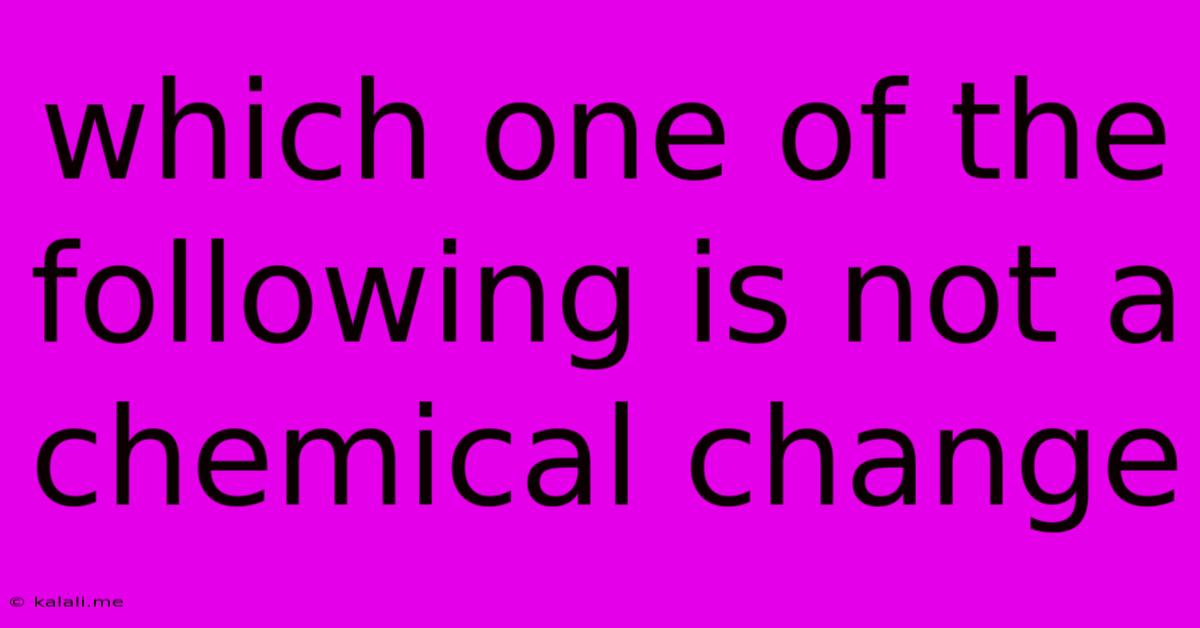Which One Of The Following Is Not A Chemical Change
Kalali
Jun 13, 2025 · 3 min read

Table of Contents
Which One of the Following is NOT a Chemical Change? Understanding Physical vs. Chemical Transformations
This article will delve into the fascinating world of chemical and physical changes, ultimately answering the question: which of a given set of examples is not a chemical change? Understanding the difference between these two types of changes is crucial for comprehending basic chemistry and many everyday phenomena. We'll explore the key characteristics of each, providing clear examples to solidify your understanding.
What is a Chemical Change?
A chemical change, also known as a chemical reaction, involves the transformation of matter into a new substance with different properties. This transformation occurs at the molecular level, resulting in the breaking and formation of chemical bonds. Key indicators of a chemical change include:
- Formation of a new substance: The products have distinctly different properties compared to the reactants.
- Change in color: A noticeable shift in color often indicates a chemical reaction.
- Production of gas: Bubbles or the release of a gas (like carbon dioxide) are common signs.
- Formation of a precipitate: The appearance of a solid from a solution.
- Change in temperature: An increase or decrease in temperature can accompany a chemical reaction (exothermic or endothermic reactions).
- Irreversibility: Many chemical changes are difficult or impossible to reverse easily.
What is a Physical Change?
In contrast, a physical change alters the form or appearance of matter without changing its chemical composition. No new substance is formed; the molecules remain the same. Examples include:
- Changes in state: Melting ice (solid to liquid), boiling water (liquid to gas), freezing water (liquid to solid), and sublimation (solid to gas).
- Changes in shape: Cutting paper, bending a wire, crushing a can.
- Dissolving: Salt dissolving in water (although the mixture is a solution, salt retains its chemical identity).
- Mixing: Combining sand and sugar (each substance maintains its individual properties).
Identifying the Non-Chemical Change: Examples
Let's consider some typical examples to illustrate the difference. Suppose we are given the following options:
A. Burning wood B. Melting ice C. Rusting iron D. Baking a cake
A. Burning wood: This is a chemical change. Wood (primarily cellulose) reacts with oxygen in the air, producing ash, gases (carbon dioxide, water vapor), and heat. The chemical composition of the wood is fundamentally altered.
B. Melting ice: This is a physical change. Ice (H₂O in solid form) transforms into liquid water (H₂O in liquid form). The chemical structure of the water molecules remains unchanged; only the state of matter changes.
C. Rusting iron: This is a chemical change. Iron reacts with oxygen and water in the presence of air, forming iron oxide (rust). The chemical composition of the iron has changed.
D. Baking a cake: This is a chemical change. The ingredients undergo complex chemical reactions (such as the Maillard reaction) during baking, creating a new substance with different properties than the individual ingredients.
Therefore, the answer to the question "Which one of the following is NOT a chemical change?" is B. Melting ice. It's a classic example of a phase transition, a physical change that only affects the state of matter, not the chemical composition.
Understanding the distinctions between physical and chemical changes is crucial for a deeper comprehension of chemistry, its applications, and the many transformations happening around us every day. By recognizing the key indicators, you can confidently distinguish between these two fundamental types of change.
Latest Posts
Latest Posts
-
Which Of The Following Statements About Viruses Is Incorrect
Jun 13, 2025
-
The Strength Of An Electromagnet Is Primarily Proportional To Its
Jun 13, 2025
-
What Is The Difference Between A Democracy And A Monarchy
Jun 13, 2025
-
Which Of The Following Prevents The Alveoli From Collapsing
Jun 13, 2025
-
The Force Of Gravity On An Object Is The Objects
Jun 13, 2025
Related Post
Thank you for visiting our website which covers about Which One Of The Following Is Not A Chemical Change . We hope the information provided has been useful to you. Feel free to contact us if you have any questions or need further assistance. See you next time and don't miss to bookmark.